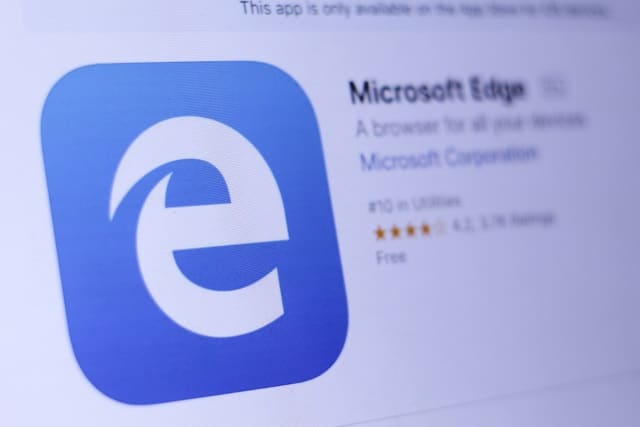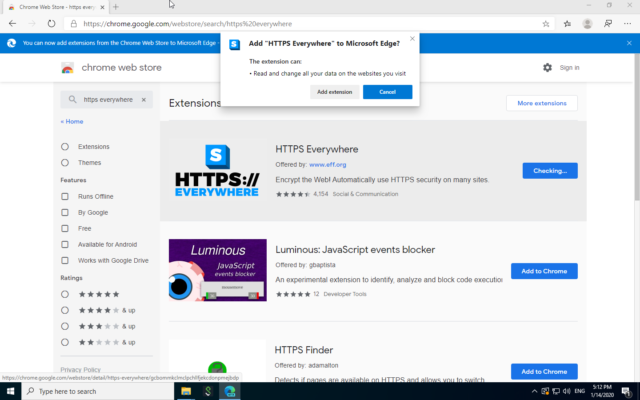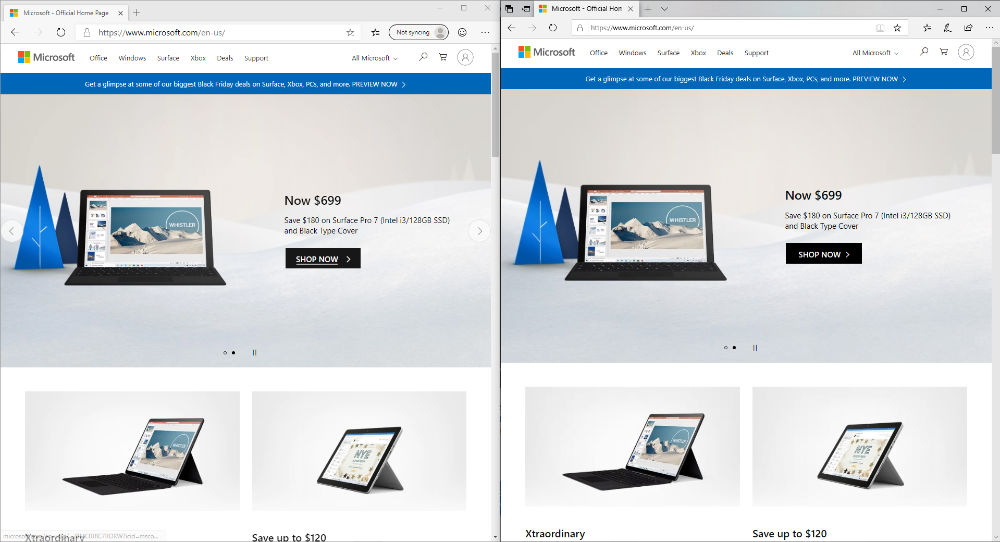- Edge Microsoft Chromium Download
- Microsoft Edge Chromium Insider
- Edge Microsoft Chromium Extension
- Microsoft Edge Chromium Beta Download
An extension is a small program that you (a developer) use to add or modify features for Microsoft Edge (Chromium). An extension is intended to improve a user's day-to-day browsing experience. It provides niche functionality that is important to a target audience.
Chromium-Based Microsoft Edge Browser. Microsoft Edge Chromium browser is the latest addition to the Microsoft's Edge series. Released on January 15th, 2020, this new version of the browser features chromium-based source code with an increased focus on security and privacy. Microsoft Edge and Chromium Open Source: Our Intent. Authors: Microsoft Edge Team Last Updated: 2018-12-06. Why this document. For the past few years, Microsoft has meaningfully increased participation in the open source software (OSS) community, becoming one of the world’s largest supporters of OSS projects.
You may create an extension if you have an idea or product that is based upon either of the following conditions.
- A specific web browser.
- Improvements to features of specific webpages.

Examples of companion experiences include ad blockers and password managers.
An extension is structured similar to a regular web app. At a minimum, it should include the following features.
- An app manifest JSON file that contains basic platform information.
- A JavaScript file that define functionality.
- HTML and CSS files that define the user interface.
To work directly with part of the browser, such as a window or tab, you must send API requests and often reference the browser by name.
Basic guidance
Some of the most popular browsers to build extensions for include Safari, Firefox, Chrome, Opera, Brave, and Microsoft Edge. Great places to begin your extension development tutorials and documentation research are sites hosted by the browser organizations. The following table isn't definitive, and may be used as a starting point.
| Web browser | Chromium-based? | Extension development webpage |
|---|---|---|
| Safari | No | developer.apple.com/documentation/safariservices/safari_app_extensions |
| Firefox | No | developer.mozilla.org/docs/Mozilla/Add-ons/WebExtensions |
| Chrome | Yes | developer.chrome.com/extensions |
| Opera | Yes | dev.opera.com/extensions |
| Brave | Yes | Uses Chrome Web Store |
| new Microsoft Edge | Yes | developer.microsoft.com/microsoft-edge/extensions |
Important
Many of the tutorials of the sites use browser-specific APIs that may not match the browser for which you develop. In most cases, a Chromium extension works as-is in different Chromium browsers and the APIs work as expected. Only some less common APIs may be strictly browser-specific. For links to the tutorials, navigate to See also.
Why Chromium?

If your goal is to publish your extension in the extensions store for each browser, it must be modified for each version to target and run in each distinct browser environment. For example, Safari extensions may use both web and native code to communicate with counterpart native applications. The last four browsers in the previous table use the same code package, and minimizes the requirement to maintain parallel versions. These browsers are based on the Chromium open-source project.
Create a Chromium extension to write the least amount of code. It also targets the maximum number of extension stores and ultimately the maximum number of users who find and acquire your extension.
The following content focuses mostly on Chromium extensions.

Browser compatibility and extension testing
Occasionally, API parity doesn't exist between Chromium browsers. For example, there are differences in the identity and payment APIs. To ensure your extension meets customer expectations, review API status through the following official browser docs.
Edge Microsoft Chromium Download
The APIs you require define the changes you must make to address the differences between each browser. It may mean that you must create slightly different code packages with small differences for each store.
To test your extension in different environments before you submit it to a browser store, sideload it into your browser while you develop it.
Publish your extension to browser stores

You may submit and seek browser extensions in the following browser stores.
Some stores allow you to download listed extensions from other browsers. However, cross-browser access is not guaranteed by browser stores. To ensure your users find your extension in different browsers, you should maintain a listing on each browser extension store.
Users may need to install your extension in different browsers. In this scenario, you may migrate existing Chromium extensions from one browser to another.
Migrate an existing extension to Microsoft Edge
If you've already developed an extension for another Chromium browser, you may submit it to the Microsoft Edge Add-ons store. You don't need to rewrite your extension, and must verify it works in Microsoft Edge. When you migrate an existing Chromium extension to other Chromium browsers, ensure the same APIs or alternatives are available for your target browser.
For more information on porting your Chrome extension to Microsoft Edge, navigate to Port Chrome extensions to Microsoft Edge (Chromium). After you port your extension to the target browser, the next step is to publish it.
Publish to the Microsoft Edge add-ons website
To start publishing your extension to Microsoft Edge, you must register for a developer account with an MSA email account to submit your extension listing to the store. An MSA email account includes @outlook.com, @live.com, and so on. When you choose an email address to register, consider if you must transfer or share ownership of the extension with others in your organization. After registration is complete, you may create a new extension submission to the store.

To submit your extension to the store, ensure you provide the following items.
- An archive (
.zip) file that contains your code files. - All required visual assets, which include a logo and small promotional tile.
- Optional promotional media, such as screenshots, promotional tiles, and a video URL.
- Information that describes your extension such as the name, short description, and a privacy policy link.
Note
Different stores may have different submission requirements. The above list summarizes the requirements to publish an extension for Microsoft Edge.
Microsoft Edge Chromium Insider
After you've successfully submitted your extension, your extension undergoes a review process and either passes or fails the certification process. Owners are notified of the outcome and given next steps as required. If you submit an extension update to the store, a new review process is started.
See also
After several years spent trying to build their own ecosystem around EdgeHTML, Microsoft called it quits and decided to switch to Chromium. The new version of their browser, also called Edge (sometimes Chromium Edge, to differentiate it from the older version) has rolled out to general applause. There have been some discussions of how it’s arguably better than Chrome itself and some worry about what it means for the internet to have a single company (Google) in such a position of browser dominance. Firefox is the only significant alternative, and Firefox’s overall market share has been falling.
Edge Microsoft Chromium Extension
In all that conversation, not much attention has been paid to a different point. You aren’t able to uninstall Chromium Edge — once it’s on your system, it’s on there for good (according to Microsoft), though those of you who are a little more familiar with digging around in the guts of Windows already have a gleam in your collective eye(s). Much as the Windows 10 giveaway theoretically ended in 2016 but is actually going on today, it’s still technically possible to uninstall Chromium Edge.
As for Microsoft’s justification for why you can’t, the company writes: “We want to ensure all Windows customers have the latest Microsoft Edge browser for the performance, privacy, security, productivity, and support features it offers.” Ironic that the company mentions privacy, since the Chromium Edge installer automatically starts importing your user data from Chrome as soon as Windows boots up post-installation. While you are asked if you wish to complete the process the browser kicks it off without so much as a by-your-leave. Not the best look.
The only reason to fall back to the old Edge compared with the new one, as far as I can tell, is if you really made use of the annotation feature, which no longer exists in the new app and will not, apparently, be returning. Apart from that, is there a huge reason to uninstall Edge?
Probably not. But it’s interesting to see how much perspectives have changed on this point going forward. Over 20 years ago, Microsoft’s decision to bundle IE with its Windows browser was the straw that sent the DOJ charging after the company. Today, the idea of shipping an OS without a browser seems more like buying a car that gets delivered to your house without any wheels. “Have fun!” shouts the truck driver, having dropped off your new car, which has helpfully arrived pre-configured for a life on concrete blocks in the front yard. Can you put tires on it? Sure. Can you drive it to a tire store to pick them out? Not exactly.
Europe, of course, famously mandated that Microsoft creates Windows N to address media application bundling concerns back in 2004. It is not clear that the various Windows N editions ever made a meaningful difference in overall software market share. There’s been no mention of revisiting this browser download issue, despite the fact that Windows 10 still arrives with Edge installed and no automatic option to install a competitor’s browser. Both Microsoft and Chrome have played dirty on the default browser issue. But Microsoft, to my recollection, is the only one to actually warn users away from alternate products:
What we needed was a happy medium between “One browser rules the Earth” and “Your browser is malware.” Image by Thurrot.com
Microsoft Edge Chromium Beta Download
One difference, of course, is that it isn’t in Google’s interest to declare Microsoft is acting like a monopoly, given that Chrome itself is an overwhelming presence in the desktop browser market. Much like ISPs have arranged themselves into monopoly or near-monopoly positions in huge swathes of the United States, Apple and Google have potent walled gardens of their own they aren’t anxious to have the government start poking around in.
Because Microsoft’s efforts to cut itself a piece of the smartphone pie largely failed, the company is now seen as a leader only in one aspect of the computing market, and it’s not a segment that’s seeing the fastest growth or investment. PCs are often treated like a legacy space — important, to be sure, but scarcely a growth industry. COVID-19 has changed that to some extent, but the work-from-home boom that’s driven an increase in PC sales isn’t going to last forever. Thus, the idea of a mandatory browser — one that made people revolt in the late 1990s — is likely to be received with a comparative yawn. After all, how else are you going to get one if you don’t have access to a PC already? The internet has become such a fundamental part of computing, an OS distro without a browser would be missing a critical part of what makes modern computing work.
I don’t think it makes sense for Microsoft to offer Windows without any browser at all as a mainstream product, but I do believe Edge should be something you can uninstall. The amount of recovered disk space is trivial, but there’s no particular value to forcing people to retain software on their PCs that they don’t otherwise use.
Now Read:
